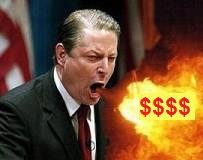I hope they all go broke!!:nuts:
You will pay for all of this not the companies! ‘Tainted’ Credits Cut UN Carbon Price: Energy Markets (Update1)
‘Tainted’ Credits Cut UN Carbon Price: Energy Markets (Update1)
By Mathew Carr
May 19 (Bloomberg) -- Emission traders’ most-profitable credits, linked to greenhouse gases considered more harmful than carbon dioxide, are dragging the United Nations carbon market to its biggest discount in a year.
The UN faces a devaluation of the tradable credits it gives investors that pay for projects to reduce hydrofluorocarbons, or HFCs, because the European Union may favor alternatives such as windfarms to combat global warming. UN offsets for 2012 traded at 4.02 euros ($4.90) a metric ton less than comparable EU permits, almost twice the spread at the end of last year.
Goldman Sachs Group Inc. and Royal Dutch Shell Plc are among investors that may get lower returns amid a clampdown on HFCs, which are known as “super gases” because they can trap 11,700 times more heat per molecule than CO2. Bloomberg New Energy Finance said the UN market may fall into two tiers by 2013, with “low quality” offsets dropping to about 7 euros versus 11 euros for those not affected by any EU discount.
“The market believes these offsets are environmentally tainted” because it is marking down HFC projects, said Alex Desbarres, an energy analyst with Datamonitor in London, which provides analysis of energy markets.
While UN Certified Emission Reduction units for delivery in 2012 are up 4.7 percent this year, their discount against EU permits for 2012 is widening on London’s European Climate Exchange. The difference was 4.20 euros a ton on May 13, the largest spread since May 20, 2009, and twice as much as in December, when envoys in Copenhagen were unable to extend the 1997 Kyoto Protocol. The December 2012 UN contract fell as much as 1.8 percent today to 11.97 euros, its lowest for a month.
Ozone Layer
HFCs, emitted in the production of chemicals for air conditioning and refrigeration, gained favor in the 1970s as an alternative to chlorofluorocarbons, or CFCs, which scientists linked to depletion of the ozone layer. While HFCs don’t interfere with the earth’s shield against damaging sunrays, they trap heat and contribute to global warming.
About half of the 408.8 million credits
issued since October 2005 by the UN’s Clean Development Mechanism, the second-largest emission markets, stem from plans to cut HFCs.
The projects are profitable because investors can get credits valued at hundreds of millions of euros after spending about $12 million to construct and $2 million a year to operate facilities that burn away HFCs before they escape into the atmosphere, according to World Bank estimates.
Tires and Chemicals [more]
http://www.bloomberg.com/apps/news?pid=20601087&sid=aK20XQ7MHofQ&pos=7

